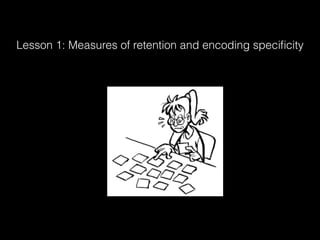Lesson 1 measures of retention
•
1 j'aime•5,874 vues
1. There are different measures of retention including recall, recognition, and relearning. Recall involves reproducing information without cues while recognition provides alternatives. Relearning shows that even if information can't be initially recalled or recognized, there may still be some memory through faster relearning. 2. The sensitivity of a retention measure refers to its ability to detect stored information. Recognition is the most sensitive while free recall is the least sensitive. 3. The encoding specificity principle states that retrieval is more likely when cues match the original learning conditions. Context-dependent and state-dependent cues can help access memories formed in a specific context or state.
Signaler
Partager
Signaler
Partager
Télécharger pour lire hors ligne

Recommandé
Recommandé
Contenu connexe
Tendances
Tendances (20)
En vedette
En vedette (16)
Similaire à Lesson 1 measures of retention
Similaire à Lesson 1 measures of retention (20)
Plus de coburgpsych
Plus de coburgpsych (20)
Lesson 1 physiological and psychological charactertistics of responses to s...

Lesson 1 physiological and psychological charactertistics of responses to s...
Dernier
Making communications land - Are they received and understood as intended? webinar
Thursday 2 May 2024
A joint webinar created by the APM Enabling Change and APM People Interest Networks, this is the third of our three part series on Making Communications Land.
presented by
Ian Cribbes, Director, IMC&T Ltd
@cribbesheet
The link to the write up page and resources of this webinar:
https://www.apm.org.uk/news/making-communications-land-are-they-received-and-understood-as-intended-webinar/
Content description:
How do we ensure that what we have communicated was received and understood as we intended and how do we course correct if it has not.Making communications land - Are they received and understood as intended? we...

Making communications land - Are they received and understood as intended? we...Association for Project Management
https://app.box.com/s/7hlvjxjalkrik7fb082xx3jk7xd7liz3TỔNG ÔN TẬP THI VÀO LỚP 10 MÔN TIẾNG ANH NĂM HỌC 2023 - 2024 CÓ ĐÁP ÁN (NGỮ Â...

TỔNG ÔN TẬP THI VÀO LỚP 10 MÔN TIẾNG ANH NĂM HỌC 2023 - 2024 CÓ ĐÁP ÁN (NGỮ Â...Nguyen Thanh Tu Collection
Dernier (20)
Kodo Millet PPT made by Ghanshyam bairwa college of Agriculture kumher bhara...

Kodo Millet PPT made by Ghanshyam bairwa college of Agriculture kumher bhara...
Making communications land - Are they received and understood as intended? we...

Making communications land - Are they received and understood as intended? we...
Fostering Friendships - Enhancing Social Bonds in the Classroom

Fostering Friendships - Enhancing Social Bonds in the Classroom
Salient Features of India constitution especially power and functions

Salient Features of India constitution especially power and functions
On National Teacher Day, meet the 2024-25 Kenan Fellows

On National Teacher Day, meet the 2024-25 Kenan Fellows
Basic Civil Engineering first year Notes- Chapter 4 Building.pptx

Basic Civil Engineering first year Notes- Chapter 4 Building.pptx
TỔNG ÔN TẬP THI VÀO LỚP 10 MÔN TIẾNG ANH NĂM HỌC 2023 - 2024 CÓ ĐÁP ÁN (NGỮ Â...

TỔNG ÔN TẬP THI VÀO LỚP 10 MÔN TIẾNG ANH NĂM HỌC 2023 - 2024 CÓ ĐÁP ÁN (NGỮ Â...
Lesson 1 measures of retention
- 1. Lesson 1: Measures of retention and encoding specificity
- 2. Recall - Being asked to reproduce information with the fewest possible cues. Free Recall – asked to remember as much information as possible in no particular order -List of grocery items Serial Recall – asked to recall information in a particular order - Names of Cities (itinerary) Cued Recall - given a cue then asked to recall Seven Dwarfs: first letter of Recall
- 3. Recognition - Identifying correct information from among alternatives. Can retrieve more this way as recognition provides more cues for retrieving from LTM. Recognition is a more sensitive measure Example – multiple choice Q’s Recognition
- 4. Relearning - Even if you can’t recall or recognise initially it doesn’t mean there is no memory. If you relearn it and learn it more quickly the 2nd time, the assumption is that there was some memory available Especially true for procedural memory - saying its like riding a bicycle - never forget how to ride a bike Savings score - if the time taken to learn the material originally can be measured and compared with the time taken to relearn the same material, then a savings score can be calculated (time for original learning) - (times for relearning) x 100% __________________________________________ (time for original learning Savings Score = Relearning
- 5. Measures of retention - sensitivity Relearning Recognition Cued recall Free recall The sensitivity of a measure of retention refers to its ability to assess the amount of information that has been stored in memory. A very sensitive measure of retention is more likely to detect information that has been learned and stored in memory at some time in the past than would a measure that is not very sensitive. Most Sensitive Least Sensitive
- 6. The encoding specificity principle The encoding specificity principle involves a general ‘rule’ that the more closely the retrieval cues match the original learning conditions, the more likely it is that the information will be recalled.
- 7. Context dependent cues are environmental cues in the specific situation (‘context’) where a memory was formed that act as retrieval cues to help access the memories formed in that context. These cues may include the sights, sounds and smells within the specific situation. Context-dependent cues
- 8. State dependent cue . State dependent cues are associated with an individual’s internal physiological and/or psychological state at the time the memory was formed, and act as retrieval cues to help access those memories. For example, if you learn information when you are happy, that information is more likely to be retrieved when you are in the same ‘state’.